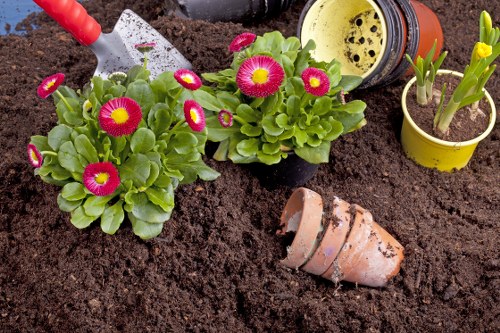Effective Driveway Algae Removal in Soho

Algae growth on driveways can be unsightly and slippery, posing safety hazards for homeowners. In Soho, where the climate can be damp and mild, algae thrive on surfaces with limited sunlight and proper moisture. Removing algae not only enhances the appearance of your property but also extends the lifespan of your driveway.
Understanding the causes of algae growth is the first step in effective removal. Algae typically flourish in shaded areas where water can accumulate and temperatures remain cool. Driveways made of porous materials like concrete or asphalt are particularly susceptible to algae infestation.
There are several methods to remove algae from driveways. From chemical treatments to eco-friendly solutions, homeowners have various options based on their preferences and the severity of the algae problem.

Why Algae Removal is Essential
Beyond aesthetics, algae on driveways can lead to structural damage over time. The presence of algae indicates moisture retention, which can erode the driveway material. This erosion not only affects the driveway's integrity but can also lead to costly repairs if left unattended.
Moreover, slippery algae surfaces increase the risk of accidents, especially during rain or after dew. Ensuring your driveway is free from algae can provide a safer environment for both pedestrians and vehicles.
Regular maintenance and timely removal of algae can prevent these issues, saving homeowners time and money in the long run.
Common Causes of Algae Growth
Several factors contribute to the growth of algae on driveways:
- Moisture: Consistent moisture from rain, dew, or improper drainage creates an ideal environment for algae.
- Shade: Areas with limited sunlight allow algae to thrive without drying out.
- Organic Debris: Accumulation of leaves and other organic materials provides nutrients for algae.
- Poor Ventilation: Stagnant air around the driveway can contribute to moisture retention.

Effective Methods for Algae Removal
There are various methods to tackle algae growth on driveways, each with its advantages and considerations:
- Pressure Washing: High-pressure water streams can effectively remove surface algae. It's a quick solution but may require professional assistance to avoid damaging the driveway.
- Chemical Treatments: Algaecides and bleach solutions can kill and remove algae. It's essential to use these chemicals carefully to prevent harm to surrounding plants and the environment.
- Eco-Friendly Solutions: Vinegar, baking soda, and hydrogen peroxide are natural alternatives that can help eliminate algae without harsh chemicals.
- Preventive Measures: Implementing proper drainage and increasing sunlight exposure can prevent future algae growth.
Step-by-Step Driveway Algae Removal
For homeowners preferring a DIY approach, here's a simple guide to removing algae:
- Clean the driveway with a broom to remove loose debris.
- Apply your chosen cleaning solution evenly across the affected areas.
- Allow the solution to sit for the recommended time to effectively kill the algae.
- Scrub the driveway with a stiff brush to remove stubborn algae.
- Rinse thoroughly with water to wash away the cleaning solution and dead algae.

Preventing Future Algae Growth
After successfully removing algae, it's crucial to take preventive steps to keep your driveway clean:
- Improve Drainage: Ensure that water flows away from the driveway to prevent moisture accumulation.
- Increase Sunlight Exposure: Trim nearby trees and shrubs to allow more sunlight to reach the driveway.
- Regular Cleaning: Periodically clean the driveway to remove organic debris that can support algae growth.
- Seal the Driveway: Applying a driveway sealant can create a protective barrier against moisture and algae.
Implementing these measures can significantly reduce the chances of algae returning, keeping your driveway pristine year-round.
Choosing the Right Professional Service
If the algae problem is extensive or if you prefer professional assistance, selecting the right service in Soho is essential. Look for companies with experience, positive reviews, and eco-friendly practices. A professional can assess the severity of the algae infestation and recommend the most effective treatment plan.

Local Expertise in Soho
Soho boasts a variety of neighborhoods, each with unique characteristics that influence algae growth on driveways. Proximity to parks, waterways, and shaded areas can affect the prevalence of algae.
- Covent Garden: Known for its bustling streets and limited green spaces, Covent Garden driveways receive ample sunlight, reducing algae growth.
- Mayfair: With its grand residences and well-maintained properties, Mayfair homeowners often invest in preventive measures against algae.
- Hoxton: This vibrant area with older buildings may experience more shade, making algae removal services in high demand.
- Soho Square: The greenery around Soho Square can contribute to moisture retention, necessitating regular algae maintenance.
- Fitzrovia: Close to Soho, Fitzrovia shares similar climate conditions, impacting driveway algae growth.
- Marylebone: With its blend of residential and commercial spaces, Marylebone driveways may require tailored algae removal solutions.
- Chinatown: High foot traffic and humidity levels in Chinatown can foster algae development on driveways.
- Earls Court: Proximity to parks and water bodies in Earls Court can increase moisture levels, favoring algae growth.
- Kensington: Exclusive homes in Kensington often have well-maintained driveways with preventive algae treatments.
- Belgravia: Prestigious residences in Belgravia prioritize driveway upkeep, reducing the likelihood of algae infestation.
- Camden: The artistic vibe in Camden includes diverse architectural styles, some of which are more prone to algae growth.
- Bloomsbury: Educational institutions in Bloomsbury contribute to varied driveway surfaces, affecting algae prevalence.
- Holborn: Mixed-use areas in Holborn require adaptable algae removal strategies for different driveway types.
- Farringdon: Urban development in Farringdon influences driveway conditions, impacting algae retention.
- King's Cross: Regeneration projects in King's Cross may include improved drainage systems to combat algae growth.
Understanding the specific needs of these areas helps in providing targeted and effective algae removal services tailored to each neighborhood's unique environment.
Conclusion
Maintaining a clean driveway free from algae is essential for both aesthetic and safety reasons. In Soho, where environmental factors can encourage algae growth, proactive measures and effective removal strategies are crucial. Whether opting for DIY solutions or professional services, addressing algae promptly ensures your driveway remains attractive and durable for years to come.
Frequently Asked Questions
1. How often should I clean my driveway to prevent algae growth?
Regular cleaning every 3-6 months, especially during damp seasons, can help prevent algae from taking hold on your driveway.
2. Are there eco-friendly options for removing driveway algae?
Yes, natural solutions like vinegar, baking soda, and hydrogen peroxide are effective and environmentally friendly alternatives to harsh chemicals.
3. Can algae damage my driveway permanently?
While algae itself doesn't cause structural damage, the moisture it indicates can lead to erosion and deterioration of driveway materials over time.
4. Is professional algae removal worth the investment?
Professional services ensure thorough removal and offer tailored solutions to prevent future growth, making it a worthwhile investment for long-term driveway maintenance.
5. How can I prevent algae from returning after removal?
Improving drainage, increasing sunlight exposure, regular cleaning, and sealing the driveway are effective measures to prevent algae from returning.


